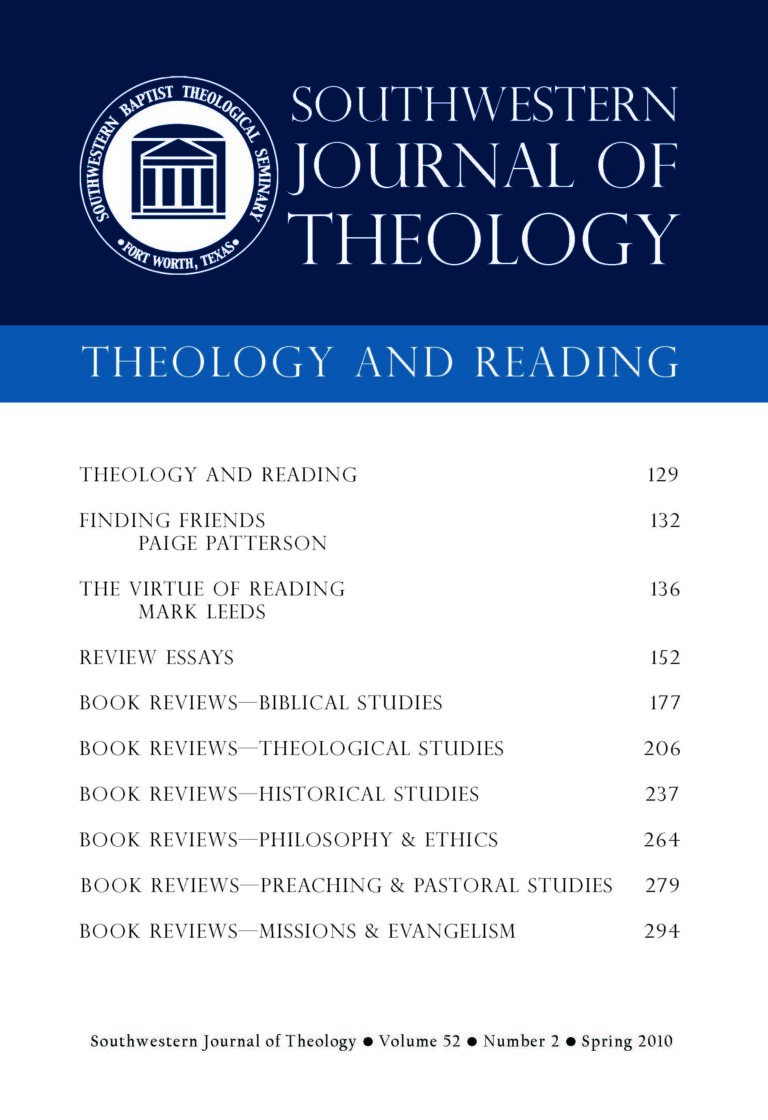
Theology and Reading
Southwestern Journal of Theology
Volume 52, No. 2 – Spring 2010
Managing Editor: Malcolm B. Yarnell III
By Jerry Sutton. Nashville: B&H Publishing, 2008. 502 + xiv pages. Hardcover, $24.99.
In 1907, the Southern Baptist Convention made its first formal attempt to impact public policy on moral issues. In honor of one hundred years of Southern Baptist engagement with culture, Jerry Sutton, pastor of Two Rivers Baptist Church in Nashville, TN, authored this volume to provide the history of Southern Baptist efforts while keeping in mind the larger historical and theological context of church-state issues.
Rather than beginning with the founding of the Committee on Civic Righteousness in 1907, Sutton offers his readers a broader historical context by providing a brief history of the development of Western civilization and the role of the church in that process. The historical survey then gives way to a theological analysis of church-state relations and public policy issues that form the backdrop for Southern Baptists’ engagement with culture.
Sutton also offers an overview of the role Baptists played in American culture in the nineteenth century, including a discussion of the issues that ultimately led to the schism between Baptists in the North and the South. After the formation of the Southern Baptist Convention in 1845, the newly organized group of Baptists found itself addressing a number of issues by way of resolutions at their annual meetings. These issues included race relations, the Sabbath, sacrificial giving, temperance, gambling, religious liberty, divorce, poverty, and peace. Such resolutions in the late nineteenth and early twentieth centuries ultimately led to the formation of a new commission tasked with addressing what could be done “for creating a more wholesome public opinion; for making the criminal laws more certain, more prompt, and more effective; so as to take away the reproach resting on civilization and religion by the prevalence of crimes and lynchings; and so as to make the law respected and effective in all parts of our common country” (85). The appointment of this Committee on Civic Righteousness in 1907 led to the establishment of the standing Committee on Temperance the following year. These committees morphed through the years, resulting in changes of name and focus, but finally reaching the current status of the Ethics & Religious Liberty Commission.
For the rest of the book, Sutton provides his readers with the history of the Committee on Temperance, Social Service Commission, Christian Life Commission, and Ethics & Religious Liberty Commission. The history is generally divided according to the leading figure of the commission at that time. The book closes with an epilogue challenging Southern Baptists to continue the work of cultural engagement and a series of appendices that accentuate the historical significance of Southern Baptist engagement with culture.
The most meaningful contribution of the book is the broad historical perspective Sutton provides as a background to Southern Baptist work. Not only does he begin with the historical and theological rationale for engaging culture, but he provides his readers with significant national and world events taking place at the same time Southern Baptists are trying to focus on issues. For example, the impetus for creating a commission to address social issues came from the temperance movement at the national level. The historical significance of wars, elections, and social movements could have been lost in a discussion of Southern Baptist work, but Sutton includes those events as the context for what was taking place in the Southern Baptist Convention for the last century.
Sutton also carefully outlines the changes on significant social issues that took place in the SBC. While many are aware of the theological shift that came with the Conservative Resurgence, fewer may be aware of the shift that took place on social issues. For example, in 1971, the Christian Life Commission presented a resolution to the convention on abortion that would be “subsequently used to help encourage the Supreme Court in its landmark Roe v. Wade and Doe v. Bolton decisions a year and a half later” (195). In effect, the commission presented resolutions that provided support for the pro-choice movement in America. It was not until 1980 that Southern Baptists publicly reversed their stance on the abortion issue. The reversal on the abortion issue demonstrates the major changes that came with the Conservative Resurgence. Sutton attempts to be fair in both his praise and criticism of the commission, especially on issues with which he fervently disagrees.
For those interested in the role that Southern Baptists have played in American culture, especially as it relates to religious liberty and social issues, this book is a worthy read. Sutton provides the historical context to show that Southern Baptists were often on the cutting edge of social issues and at other times woefully lagging behind. In the end, it provides motivation to stay engaged with culture by proclaiming the life-changing message of the gospel.





